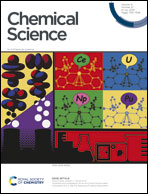Pt cocatalyst morphology on semiconductor nanorod photocatalysts enhances charge trapping and water reduction†
Abstract
In photocatalysis, metal–semiconductor hybrid structures have been proposed for ideal photocatalytic systems. In this study, we investigate the effect of morphology and surface nature of Pt cocatalysts on photocatalytic hydrogen evolution activity in Pt-tipped CdSe nanorods. Three distinct morphologies of Pt cocatalysts were synthesized and employed as visible light photocatalysts. The rough tips exhibit the highest activity, followed by the round and cubic tips. Kinetic investigations using transient absorption spectroscopy reveal that the cubic tips exhibit lower charge-separated states feasible for reacting with water and water reduction rates due to their defectless surface facets. In contrast, the rough tips show a similar charge-separation value but a two-fold higher surface reaction rate than the round tips, resulting in a significant enhancement of hydrogen evolution. These findings highlight the importance of rational design on metal cocatalysts in addition to the main semiconductor bodies for maximizing photocatalytic activities.



 Please wait while we load your content...
Please wait while we load your content...